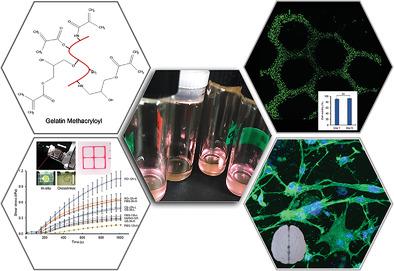当前位置:
X-MOL 学术
›
Macromol. Biosci.
›
论文详情
Our official English website, www.x-mol.net, welcomes your
feedback! (Note: you will need to create a separate account there.)
Designing Gelatin Methacryloyl (GelMA)‐Based Bioinks for Visible Light Stereolithographic 3D Biofabrication
Macromolecular Bioscience ( IF 4.4 ) Pub Date : 2020-10-11 , DOI: 10.1002/mabi.202000317 Hitendra Kumar 1, 2 , Kabilan Sakthivel 1 , Mohamed G A Mohamed 1 , Emilie Boras 3 , Su Ryon Shin 4 , Keekyoung Kim 1, 2
Macromolecular Bioscience ( IF 4.4 ) Pub Date : 2020-10-11 , DOI: 10.1002/mabi.202000317 Hitendra Kumar 1, 2 , Kabilan Sakthivel 1 , Mohamed G A Mohamed 1 , Emilie Boras 3 , Su Ryon Shin 4 , Keekyoung Kim 1, 2
Affiliation

|
Bioinks play a key role in determining the capability of the biofabricatoin processes and the resolution of the printed constructs. Excellent biocompatibility, tunable physical properties, and ease of chemical or biological modifications of gelatin methacryloyl (GelMA) have made it an attractive choice as bioinks for biomanufacturing of various tissues or organs. However, the current preparation methods for GelMA‐based bioinks lack the ability to tailor their physical properties for desired bioprinting methods. Inherently, GelMA prepolymer solution exhibits a fast sol–gel transition at room temperature, which is a hurdle for its use in stereolithography (SLA) bioprinting. Here, synthesis parameters are optimized such as solvents, pH, and reaction time to develop GelMA bioinks which have a slow sol–gel transition at room temperature and visible light crosslinkable functions. A total of eight GelMA combinations are identified as suitable for digital light processing (DLP)‐based SLA (DLP‐SLA) bioprinting through systematic characterizations of their physical and rheological properties. Out of various types of GelMA, those synthesized in reverse osmosis (RO) purified water (referred to as RO‐GelMA) are regarded as most suitable to achieve high DLP‐SLA printing resolution. RO‐GelMA‐based bioinks are also found to be biocompatible showing high survival rates of encapsulated cells in the photocrosslinked gels. Additionally, the astrocytes and fibroblasts are observed to grow and integrate well within the bioprinted constructs. The bioink's superior physical and photocrosslinking properties offer pathways of tuning the scaffold microenvironment and highlight the applicability of developed GelMA bioinks in various tissue engineering and regenerative medicine applications.
中文翻译:

设计用于可见光立体光刻 3D 生物制造的基于明胶甲基丙烯酰 (GelMA) 的生物墨水
生物墨水在确定生物制造过程的能力和打印结构的分辨率方面起着关键作用。甲基丙烯酰明胶 (GelMA) 优异的生物相容性、可调的物理特性以及易于进行化学或生物修饰,使其成为用于各种组织或器官生物制造的生物墨水的有吸引力的选择。然而,目前基于 GelMA 的生物墨水的制备方法缺乏为所需的生物打印方法定制其物理特性的能力。本质上,GelMA 预聚物溶液在室温下表现出快速的溶胶-凝胶转变,这是其在立体光刻 (SLA) 生物打印中使用的障碍。在这里,合成参数得到优化,例如溶剂、pH、和反应时间来开发 GelMA 生物墨水,它在室温下具有缓慢的溶胶-凝胶转变和可见光可交联功能。通过对其物理和流变特性的系统表征,共有八种 GelMA 组合被确定为适用于基于数字光处理 (DLP) 的 SLA (DLP-SLA) 生物打印。在各种类型的 GelMA 中,在反渗透 (RO) 纯净水中合成的那些 (简称 RO-GelMA) 被认为最适合实现高 DLP-SLA 打印分辨率。还发现基于 RO-GelMA 的生物墨水具有生物相容性,显示出光交联凝胶中封装细胞的高存活率。此外,观察到星形胶质细胞和成纤维细胞在生物打印结构内生长和整合良好。生物墨水'
更新日期:2020-10-11
中文翻译:

设计用于可见光立体光刻 3D 生物制造的基于明胶甲基丙烯酰 (GelMA) 的生物墨水
生物墨水在确定生物制造过程的能力和打印结构的分辨率方面起着关键作用。甲基丙烯酰明胶 (GelMA) 优异的生物相容性、可调的物理特性以及易于进行化学或生物修饰,使其成为用于各种组织或器官生物制造的生物墨水的有吸引力的选择。然而,目前基于 GelMA 的生物墨水的制备方法缺乏为所需的生物打印方法定制其物理特性的能力。本质上,GelMA 预聚物溶液在室温下表现出快速的溶胶-凝胶转变,这是其在立体光刻 (SLA) 生物打印中使用的障碍。在这里,合成参数得到优化,例如溶剂、pH、和反应时间来开发 GelMA 生物墨水,它在室温下具有缓慢的溶胶-凝胶转变和可见光可交联功能。通过对其物理和流变特性的系统表征,共有八种 GelMA 组合被确定为适用于基于数字光处理 (DLP) 的 SLA (DLP-SLA) 生物打印。在各种类型的 GelMA 中,在反渗透 (RO) 纯净水中合成的那些 (简称 RO-GelMA) 被认为最适合实现高 DLP-SLA 打印分辨率。还发现基于 RO-GelMA 的生物墨水具有生物相容性,显示出光交联凝胶中封装细胞的高存活率。此外,观察到星形胶质细胞和成纤维细胞在生物打印结构内生长和整合良好。生物墨水'











































 京公网安备 11010802027423号
京公网安备 11010802027423号